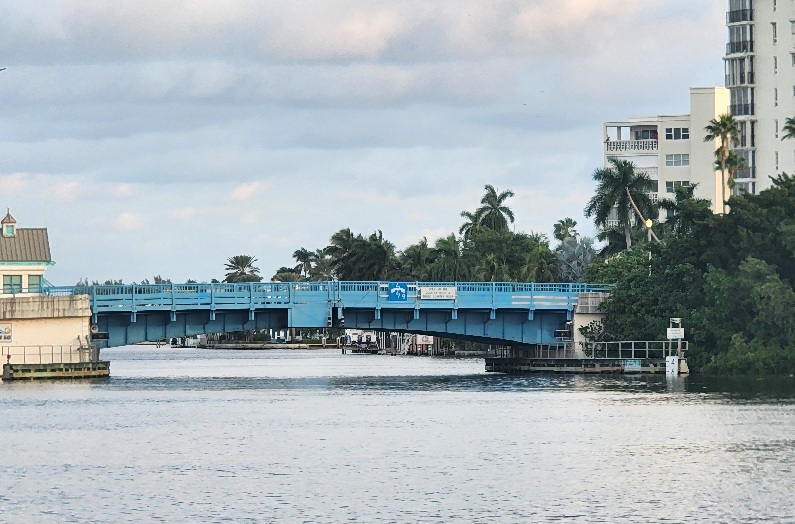“Why bother with these painful bridges? Why not just go outside?” is the question many of our fellow sailors asked us. Simply answer is because we wanted to cross the ICW off our list and visit as many ports and towns on the eastern shore of our country as possible. And we will most likely be going offshore for our trip on the way back home.
Looking ahead at our ICW navigational charts, we couldn’t help but cringe at the plethora of restricted bridges and thought now was as good a time as any to describe these structures and their role in our trip, as these bridges are such a huge part, and headache, of our daily travels, they deserve a separate post on its own.
The 1,095 miles of the Atlantic Intracoastal Waterway contain 137 bridges of which 81 need to open for sailboats (and many powers too). In the last 130 mile stretch there’s 41 opening bridges of which 22 are restricted.
The styles of bridges are varied: swing, bascule (hinged and raises open from the hinge), fixed (non opening) – 99% have 65′ clearance at high tide, lift (railroad only) or pontoon. We’ve only encountered two lift bridges, both just south of Norfolk. They function as the name implies, they lift up parallel to the ground attached to metal tower-like structures on each side of the waterway. Massive describes them well. The ICW has one automatic single-bascule railroad bridge at Mile 876 (Titusville (NASA)) which we passed through on our way here. It’s usually open, but when a train in due, the green lights will change to flashing red and a horn continuously sounds four blasts for eight minutes. At that point the bridge will close as long as the scanning equipment shows nothing under the bridge.
If a bridge is of the opening variety, then life becomes more interesting and boredom can be greatly reduced. The flavors are: restricted, on-demand or a mixture of the two. The flavors can alternate between weekends and weekdays. If a bridge is always restricted to a set schedule you simply have to adjust your speed and take into account the myriad of factors that can influence your speed and ability to make the desired opening time. A common schedule we encountered prior to Florida was “Open on the hour and half hour”, but there were bridges that only opened on the hour. When you have several of these types in a 15 mile span, the calculator and chartplotter are your friends. Florida has a plethora of bridges, but we were recently on a joy run of no opening bridges for 79 miles!
On-demand bridges provide an opportunity to talk, however briefly, with someone new. If you want to communicate with a bridge tender, you call him or her on the appropriate channel using the VHF marine radio. Most states use Channel 13, but some like Florida use Channel 9. Channel designation is regulated by the Coast Guard. Channel 16 is the “monitoring” channel and the one used for distress calls.
A typical bridge hailing would go something like this: (first be sure you are on the correct channel) “Atlantic Avenue bridge this is the southbound sailing vessel Fujiko requesting for your next opening.” With any luck you have another boat or two behind you. The bridge will acknowledge your call and indicate that they will open when all boats are close enough. For some reason that we have yet to figure out, bridgetenders will often ask for the boat name AND where from. This occurs when several boats are making the passage. Once you are clear, most vessels will thank the bridge tender for the opening and say they have cleared the bridge.
Not all, but most bridge tenders are friendly and courteous. One clearly enjoyed her job and she was a hoot! A real southern accent and she was talking to each boat like we were best friends. “Keep it coming darlin’, watch that crab pot in front of ya. That’s it. Y’all have a good day now.” The trick to ensuring a prompt response to your call is to use the correct name of the bridge, be polite yet confident and provide the necessary info clearly. If you see a boat a short distance in front of or behind you, indicating that you will slow down or speed up for the opening is always an appreciated gesture.
In summary, good planning is a must for successful ICW bridge crossings. This leads to plenty of strategising, as you either hurry to get to the next bridge in time to avoid milling around with a bunch of other boats waiting for the next opening, or slow down so you don’t get there too soon. What’s more, many of the metropolitan bridges don’t open at all during morning and evening rush hours. In the end, diligent study of bridge locations and timetables was the key to our successful & less stressful passages through these gauntlet of bridges.


Very interesting and informative discussion of the ICW bridge system.
Along with other cruiser’s advice and navigational charts, I used to rely on the Embassy Cruising Guide when planning trips on Haven. As a post retirement career, you guys would be great writers for an online cruising guide. Informative, funny, inspirational…
Maybe I should have kept my boat!
You definitely should have kept the boat Dennis. We could be buddy boating on our way to the Bahamas right now. Regarding writing, we’re not real writers, we’re just trying to keep a journal of our trip so we can remember what the heck happened to us and where we’ve been. Even now, we have to look back at our blogs to see where we were just a few weeks ago. Everything seems to be very foggy at our age.